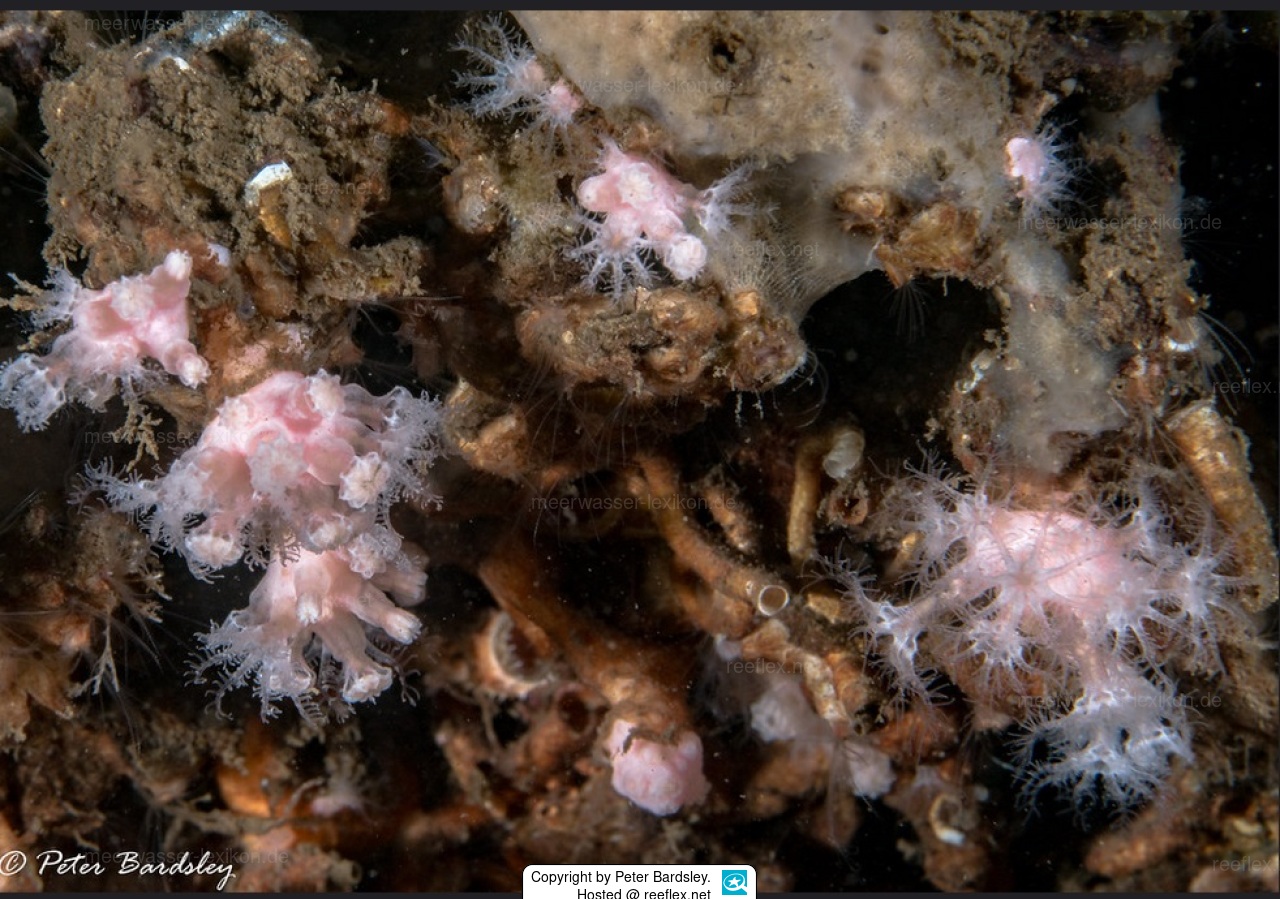Info
Very special thanks for the first photo of this beautiful, tiny soft coral to Peter Bardsley, Penrith, United Kingdom.
In the waters around the British Isles, for example around the Isle of Man, the soft coral species Alcyonium digitatum and Alcyonium hibernicum occur together.
It is interesting to note that these two species have very different reproductive strategies:
Alcyonium digitatum has the same number of male and female colonies, spawns in mid-winter and releases the gametes into the water where fertilization and embryogenesis take place to produce pelagic planulae.
Alcyonium hibernicum has only female colonies and spawns in late summer: the eggs develop parthenogenically, the embryos are hatched and the planulae are benthic.
It is assumed that the main reason for these differences is the smaller size of Alcyonium hibernicum, with reduced reproductive resources not sufficient to ensure replacement by mechanisms adequate for the larger Alcyonium digitatum.
To compensate for this, reproductive efficiency has been improved, but only by abandoning the main mechanisms of genetic variation and spread of the species.
This small soft coral typically forms Alcyonium-like fingers of up to 40 mm in height. It is pink in colour, with white spots on the tentacles.
Habitat: It can be found in places somewhat sheltered from strong waves and out of light, such as under ledges, on rocks with little algae growth, under overhangs, in crevices, caves, on wrecks, etc.
May also occur in estuaries with slightly reduced salt content.
Ecology: Known for the production of larvae that settle near the parent colony, resulting in a very localized distribution.
Distribution: Very localised on the west coast of the British Isles, north to Mull, west of Scotland. May occur quite frequently in suitable localities.
Similar species:
May be confused with small colonies of Alcyonium digitatum, but habitat preferences, colour and "tufted" appearance of polyps should allow positive identification.
Note:
Prof. Dr. Catherine McFadden has shown in a study that there are two different forms of Alcyonium hibernicum, a northeastern form around the British Isles (on the west coast of the British Isles, north to Mull, west of Scotland) and a form in the Mediterranean Sea.
Synonyms:
Alcyonium pusillum Tixier-Durivault & Lafargue, 1966
Parerythropodium hibernicum Renouf, 1931
In the waters around the British Isles, for example around the Isle of Man, the soft coral species Alcyonium digitatum and Alcyonium hibernicum occur together.
It is interesting to note that these two species have very different reproductive strategies:
Alcyonium digitatum has the same number of male and female colonies, spawns in mid-winter and releases the gametes into the water where fertilization and embryogenesis take place to produce pelagic planulae.
Alcyonium hibernicum has only female colonies and spawns in late summer: the eggs develop parthenogenically, the embryos are hatched and the planulae are benthic.
It is assumed that the main reason for these differences is the smaller size of Alcyonium hibernicum, with reduced reproductive resources not sufficient to ensure replacement by mechanisms adequate for the larger Alcyonium digitatum.
To compensate for this, reproductive efficiency has been improved, but only by abandoning the main mechanisms of genetic variation and spread of the species.
This small soft coral typically forms Alcyonium-like fingers of up to 40 mm in height. It is pink in colour, with white spots on the tentacles.
Habitat: It can be found in places somewhat sheltered from strong waves and out of light, such as under ledges, on rocks with little algae growth, under overhangs, in crevices, caves, on wrecks, etc.
May also occur in estuaries with slightly reduced salt content.
Ecology: Known for the production of larvae that settle near the parent colony, resulting in a very localized distribution.
Distribution: Very localised on the west coast of the British Isles, north to Mull, west of Scotland. May occur quite frequently in suitable localities.
Similar species:
May be confused with small colonies of Alcyonium digitatum, but habitat preferences, colour and "tufted" appearance of polyps should allow positive identification.
Note:
Prof. Dr. Catherine McFadden has shown in a study that there are two different forms of Alcyonium hibernicum, a northeastern form around the British Isles (on the west coast of the British Isles, north to Mull, west of Scotland) and a form in the Mediterranean Sea.
Synonyms:
Alcyonium pusillum Tixier-Durivault & Lafargue, 1966
Parerythropodium hibernicum Renouf, 1931







 Peter Bardsley, Vereinigtes Königreich
Peter Bardsley, Vereinigtes Königreich





















